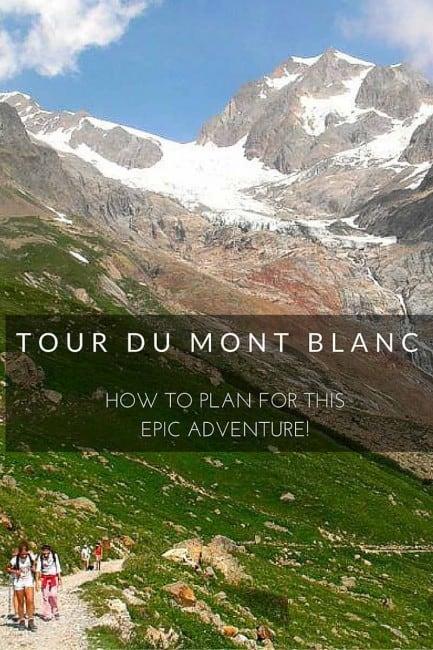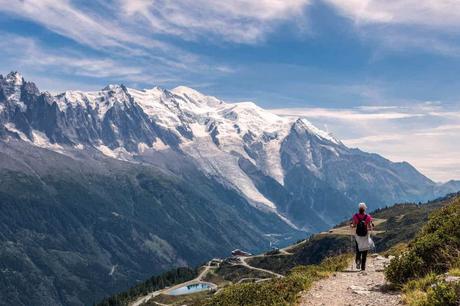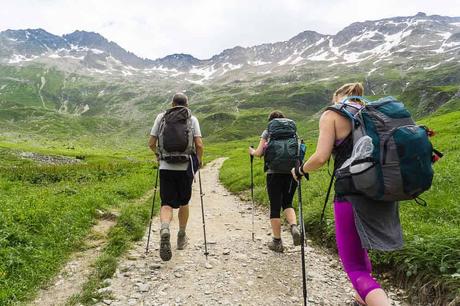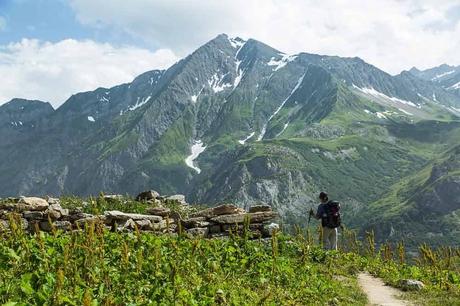The Tour du Mont Blanc (TMB) is not only one of the most popular hikes in Europe but one of the best treks in the world!

The 160km, 8000+ elevation gain trek around the highest peak (4810 m) in Western Europe is a classic! Having completed it through France, Italy, and Switzerland, I can highly recommend it.
Although you don't go to the peak itself (that involves mountaineering), it's tough. It will challenge you both physically and mentally, but with a little bit of planning, you can choose how much of a challenge you want.
BOOK BEFORE APRIL 15TH & GET OUR SAVINGS FARE!3 Ways You Can Hike the TMB
1. Guided TMB Trek
This is a good option if you want to leave the route-finding to a skilled guide and also want local knowledge. Our French guides will point out things along the way you'd never spot on your own. A guided tour is also a good option if you enjoy the camaraderie of meeting fellow hikers.
We offer a 10-day guided hike that includes all your meals and luggage transfers in dormitory accommodation on three different dates:
- June 22nd -July 1st
- July 22nd -July 31st
- September 2nd - September 11th
Note: We need to confirm numbers for the accommodations by the end of March. And there are limited spaces so if you're interested in a guided tour don't delay your booking.
2. Self-Guided TMB Trek
There are also self-guided treks of the Tour du Mont Blanc, in which a tour operator consults with you and makes all the arrangements best suited to your needs and wants. This is one of my favourite ways of doing treks. You can avoid the mistakes that we did by planning it all ourselves - see below. After booking this tour on my own, I now almost always choose the self-guided and sometimes the guided option.
Because I'm such a big fan of self-guided hikes, we offer 6, 7 or 10-day tours. You choose whether you want to stay in huts or private accommodation. And you also have the option to carry your luggage or have it transferred.
Self-guided tours are a good option if you want the flexibility of hiking at your own pace and starting when you want to. They're also a good option if you want to spend quality time with the person(s) you're hiking with.
The TMB route is well-signed and we provide a detailed map and instructions but you still get to figure out a few things on your own, like whether you want to choose the easier or more difficult but more scenic path. I personally love this stuff. But I don't love booking accommodations and trying to figuring out everything on my own from scratch. It's very time-consuming. I'd rather rely on experts but then have the flexibility of hiking by myself.
BOOK BEFORE APRIL 15TH & GET OUR SAVINGS FARE!3. Hiking the Tour du Mont Blanc On Your Own
Another alternative is to plan your TMB adventure on your own. It's the most time consuming, but also the cheapest option, especially if you're camping. Below you'll find the how to plan your own trek if you're staying in mountain huts.
Resources for Planning Your Own TMB Hike
If you choose the do it yourself option, I recommend that you plan it using a combination of this site, and the Tour of Mont Blanc: Complete Two-Way Trekking Guide Book by Cicerone Guides. And of course a good map.
The site shows you the availability of the refuges (mountain huts) and how long it takes to hike to the other hut.
You're also able to book the huts directly through their site. This is very time-consuming. However, it has the advantage of being the second cheapest option for trekking the TMB.
The cheapest option for doing the TMB is camping. However, as I didn't camp, I, unfortunately, can't offer any advice on that.
Choose Your Starting Point for the TMB
We started in Chamonix, known as the Capital of Extreme for all of its climbing, mountaineering and rafting activities. But it depends on the length of your tour. We start our 6 and 7-day tours in the nearby village of Les Houches. It's also a popular starting point and easily reached from Chamonix.
Travel tip: If you do decide to start in Les Houches ensure you buy everything you need in Chamonix first. We walked from Chamonix to Les Houches and had to take the bus back to Chamonix again to buy an iPhone cable. It's a very small village where only very basic supplies are available.
Choose the Direction you will Trek the Tour du Mont Blanc:

We did a combination of hiking on our own and with other people, we met on the trail, including a fellow Canadian!
You can spend as much, or as little time with other people as you choose. It's really up to you!
Decide How Many Days to Hike the TMB
Don't start by saying that you will do the trek in so and so many days. Take a look at the itineraries for the self-guided and guided tours and see whether the 6, 7 or 10-day tour, is the best choice for you.
On our tours, the 6 and 7-day tours are the easiest (although not easy). You take transfers skipping the less scenic parts. Our 10-day tour is the most challenging with more hiking and fewer transfers.
If you're new to hiking and the TMB is your first long-distance hike, it's a good idea to start with a 6 or 7-day tour in which you hike less each day. This is a good way to ease into long-distance hiking. The 6 and 7-day tours are also good options if you don't hike regularly and are in OK but not great shape.
If you're in good shape, hike regularly and love a challenge, then the 10-day tour is an excellent choice for you.
Of course, you may be limited by vacation time. In that case, even if you're in excellent shape, you could still choose a shorter tour, then opt to hike some sections instead of taking the transfer. That way, you'll make it harder.
You can use these guidelines, even if you're planning on doing the Tour du Mont Blanc on your own.
Check out this TMB Video
What I Didn't Like About Booking Through the TMB Site:
The disadvantage to the TMB site though is that it doesn't provide the elevation gain, nor the distance. It's also only possible to book some refuges by phone. And the ones you book by email can be slow (if they bother) in responding to you.
We called a few and found some didn't speak English or German, the only two languages we speak.
Also, each booking is dependent on each other. I.e. you want to have your reservation secured for Days 1,2, 3 before you book for Day 4. That way you ensure that you don't have too short a day or too long.
Furthermore, after we confirmed our booking, two refuges contacted us a few days later to tell us they were full. As a result, we had to start our bookings from scratch. This happened twice.
It took me hours and hours to plan our TMB adventure, then replan, then replan our route again. It's doable but very time-consuming. It took us approximately 12 hours to book and plan everything. And it was incredibly frustrating.

That's why if you're short on time, I highly recommend doing a self-guided or guided tour of the Tour du Mont Blanc. You let someones else make all the time-consuming bookings for you. Note: even for us, the bookings are time-consuming. Sometimes we physically go to the huts to confirm a booking.
After planning the TMB on my own the first time doing this once, I wouldn't do it again. That's why I started offering tours - to help make it easier for fellow TMB hikers.
On future hikes, I used self-guided tours for hiking the Dolomites, Wicklow Way in Ireland and the last 100 km of the Camino de Santiago in Spain and from Dana to Petra Trek in Jordan I did a guided hike.
BOOK BEFORE APRIL 15TH TO SAVE!The Disadvantage of Not Knowing Which Mountain Huts to Book
Lastly, some of the mountain huts/refuges are nice, some less so. We stayed in a four-bedroom at one which was nice, but the dorm room was awful! The beds were both inches off the floor and from each other. Keeping in mind that you may be sleeping next to a stranger!
We also heard horror stories of refuges that were filthy. We stayed in one in Switzerland after a 13 1/2 day of trekking that wasn't exactly disgusting, but not exactly clean either. And the staff was unwelcoming. Neither helped my tired mode.
Note: I am not able to tell you the mountain huts that I wouldn't recommend. The last time I did the full TMB was several years and things may have changed.
I'm also eager to avoid a lawsuit, which has happened to other bloggers who've said less than complimentary things about hotels (not on the TMB). It's also as a courtesy to our clients who book their TMB Trek through us and are paying for our expertise.
That's another advantage to doing a self-guided or guided tour. We have the insider knowledge of which accommodations offer something special. And which ones to avoid!
Other Thing to Keep in Mind When Hiking the TMB:
The Option of Easier vs More Challenging Routes
On some days of the TMB, you will have the option of an easier or more challenging route. On these days see how you're feeling. I.e. how sore you are and how tired you are.
Don't be afraid to choose the easier route if your legs are burning or if you're exhausted. It's important to challenge yourself on multi-day hikes but without overdoing it. That can easily wreck the rest of your hike.
Weather on the TMB
It's also critical to consider the weather. We had one day that I wanted to take the longer route. Unfortunately, the heavy rain made it inadvisable. It's important to consider safety. Besides, if it's raining heavily, you likely wouldn't have the spectacular views that you were searching for on a more challenging route.
When you're hiking in the mountains the weather can change quickly. All the mountain huts will have the weather posted. If not you can ask.
On days when a thunderstorm is predicted in the afternoon, you can get an earlier start and take a shorter lunch break to try to avoid it.
The terrain on the TMB
You'll mainly be hiking on well-marked trails through mountain passes, meadows filled with wildflowers and valleys. It's absolutely stunning.
If you choose the 10-day trek, that often means going up two separate cols/mountain passes. Keep in mind that you will likely be much slower later on in the day when your legs are already tired.
Travel Insurance for the TMB
Also, remember to purchase Travel Insurance. You hope you won't need it, but mountain rescues are expensive - a minimum of €5000. And they can easily be much more expensive depending on your location and the complexity of the rescue.
I had a friend hiking in the Dolomites who required a helicopter rescue because she tore ligaments in her knee which required surgery to repair.
Sometimes injuries aren't life-threatening but if you tear ligaments, slip and break your ankle, you won't be able to hike down on your own. It's better to purchase travel insurance (being sure that it includes mountain rescue, and hope that you don't need it.
How to Pack for the Tour du Mont Blanc
I've written a comprehensive post on this indicating every essential item while eliminating those that you don't need. Check it out!
Our 8 Day Schedule of Trekking the Tour du Mont Blanc
This is NOT a recommendation but is what we did. I'm providing it as many of you have asked for our route. We had some long days, including a 13 1/2 hour one. If you've ever hiked for that long in the pouring rain, you know that's not much fun. Again, I wouldn't recommend what we did.
If you're looking for recommendations check out our self-guided and guided Tour du Mont Blanc treks. You'll get an idea for a much better itinerary even if you're not planning on booking our tour.
Also worth noting is that our start to finish time includes a short lunch stop and breaks in between. We walked every kilometre and didn't take any public transportation. I will take ten days when I hike it again.

Day 2: Refuge Fioux to Refuge Nant Borrant: Start to finish time: 9.5 hours, 25 km
Day 3: Refuge Nant Borrant to Refuge Mottets: Start to finish time: 9.9 hours, 22 km, 1300 m elevation
Day 4: Refuge Mottets to Refuge Mont Blanco: Start to finish time: 9.8 hours, 17 km, 740 m elevation
Day 5: Refuge Mont Blanc to Refuge Bonatti: Start to finish time: 7.1 hours, 21 km, 800 m elevation
Day 6: Refuge Bonatti to La Fouly: Start to finish time: 6.5 hours, 18 km, 600 m elevation
Day 7: La Fouly to Trent: Start to finish time: 13.5 hours, 35 km, 800 m elevation
Day 8: Trent to Chamonix: Start to finish time: 10 hours, 25 km, 900 m elevation
Hiking Times on the TMB

We had one long day listed as just over 9 hours of hiking. That seemed long but doable. It ended up taking us over 13 1/2 hours (including breakfast and a lunch stop). By the time we finally hit the second bit of elevation, we were already 22km into our hike.
We did the remaining 700m of elevation at a tortoise pace. It rained the entire day and we didn't see Mont Blanc once in the 13 1/2 hours of hiking.
Several years later, I look back on that day and still shudder. Anyone who was familiar with TMB Trail would have known that trekking from La Fouley to Trent was not a good idea. That's especially when you're carrying a heavy backpack with all your belongings.
Eating with Dietary Issues at the TMB Mountain Huts
I have a gluten allergy and told all of the refuges before we left. Despite that, two of them claimed to be unaware of my allergy. My guess is that they were either busy and forgot. It's also possible that the language barrier played a part. Note French, Italian, and German are spoken with varying degrees of English depending on the mountain hut.
One place made up for it quite well. While another one served me a salad. Safe to say that it didn't exactly hit the spot after hiking for hours.
It was also a problem at breakfast where typically just bread was served. None of the refuges had gluten-free bread. Instead, I requested a piece of fruit.
We ordered lunches to go the night before from each hut. Despite being informed ahead of time, lunch was usually sandwiches which I couldn't eat. As a substitute, I'd be given 3 or 4 apples instead.
If you have any special dietary needs, many of the mountain huts won't be able to accommodate them satisfactorily. In this case, I highly recommend the private accommodation option versus the mountain hut option.
You'll be staying at more hotels/inns. They're better equipped to handle dietary preferences. At the mountain huts, there are are two options for dinner. A regular meal and a vegetarian one. The same three to four-course meals are served for everyone unless you make special arrangements.
You can find out more about what it's like to stay at a mountain hut here.
To Reserve or Not to Reserve Refuges on the Tour du Mont Blanc Trail?:
As we planned our trek ourselves, we reserved all of our refuges along the TMB in advance. We wanted to enjoy our holiday. And not be on our phone each day trying to call ahead to see if there was space. We also didn't want just to show up and find out there was no space left.
The disadvantage of this is that it allowed us no flexibility. The advantage was that we never had to worry about finding a place to sleep. And - in theory, each place knew in advance about my gluten allergy.
As it turned out, all of the refuges we stayed at, did have space. Reservations may not always be necessary, but often the only space left was in a dormitory, and we preferred to sleep in private rooms when possible.
Update: Since I did the TMB several years ago it's gotten much busier. The mountain huts are often booked months in advance. We sometimes have difficulty finding space as early as March for July dates. I highly recommend booking in advance.Travel tip: If you don't have reservations for a mountain hut, then try to get an early start and arrive early. That way you may get a spot before it does come full with other hikers who have the same idea.
Pamper Yourself at the Beginning and End of Your Tour du Mont Blanc Trek
We stayed at the Hôtel Les Aiglons, Resort & Spa the night before our trek and at Boutique Hôtel Le Morgane on the last day of our trek. Both are four-star eco hotels in Chamonix, complete with a spa!
After staying in refuges, it was pure bliss. We sat on our huge patio enjoying the killer views of Mont Blanc, as we rested our blistered, aching feet. Trust me, on the final day; you'll likely be tired, so it's worth a bit of a splurge!
So How Did Planning our Own TMB Trek Planning Work Out?
Overall it worked out OK for us. We did it in 8 days. If you want to do the full route I'd recommend 10 days. We did have several long days, which were manageable, but our 13 1/2 hour day was way too long.
I was THISCLOSE to calling a taxi for the last 3km but sustained. In truth, my partner at the time wisely prevented me. It would have been nice to have had an extra day or two. That would have significantly reduced the hours we hiked on some of the very long days.
I liked all the refuges we stayed in, with one exception.
The Best Thing About Hiking the TMB
The sense of accomplishment. Knowing that we did it. And enjoyed most of it. Even better, it left me a lasting gift that is still giving. The gift of personal strength, both on and off the mountain. Check out How a Hiking Trip Can Change Your Life. Check out my Tour du Mont Blanc Packing List! BOOK BEFORE APRIL 15TH TO SAVE! I don't believe anyone who says they enjoyed every second of the TMB. There are some tough parts! And there are times you may question why you're doing it.
Note: Originally published in 2013, updated in Jan 2016 and most recently in Feb, 2019.

